Lockwood
Custom Optics at the
|
Dodging smoke As I sat in a very stupid construction traffic jam just north of Kansas City, I pondered how dumb people had to be to allow this type of backup to form, and I also noticed the haze in the air. It occurred to me what a great idea it would be to do the type that brings traffic to a complete crawl (because they are practically working in the one open lane) at night instead of during peak traffic hours. Flashback to the Winter Star Party this year - while it ruined a couple of our observing nights, the night road work prevented a catastrophic backup of traffic in the Florida Keys. After losing yet another half hour of my life to idiotic traffic in Missouri, I was finally approaching the north side of Kansas City when I noticed the silhouette of something very large in the sky - a blimp. In fact, it was the Goodyear blimp, and it was there to cover the season-opener for the Kansas City Chiefs that Thursday night. I had no idea because the NFL had not been on my mind for the last few weeks before the Okie-Tex Star Party of 2023. I will back up a little bit and explain why. Some time after WSP, the thought of simplifying the nightvision observing system occurred to me again. I had thought about it for a while, because there were a lot of lens surfaces in the eyepiece, corrector, and nightvision objective (around 16 lenses), and I knew that something simpler could be built that would likely have better image quality. So, I sent a message to Mike Jones, and a conversation began. That conversation soon involved some vendors, and the next thing I knew, it was time to build a prototype. I had finally managed to schedule some free time for myself to do some projects around the house during the summer, and also time to put together something completely new. 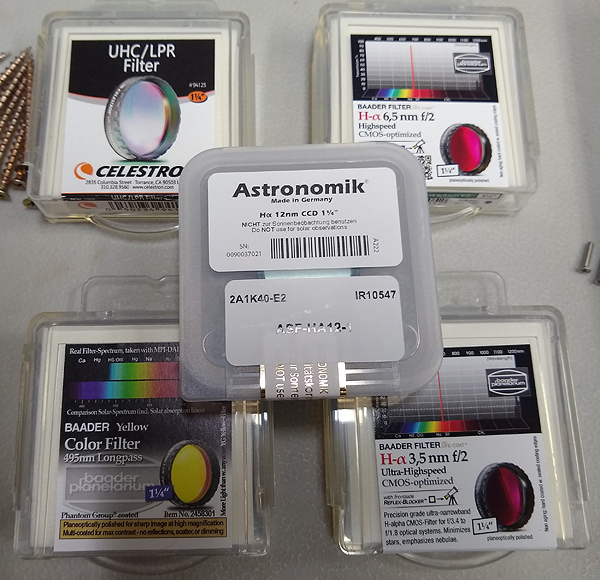 Thus, it was building a prototype telescope that had occupied my mind for those three
weeks or so prior to Okie-Tex, and it turned out very well. I learned a lot of machining
tricks and practical methods for my machines, and I found various
parts and accessories that I needed to
make some parts on my lathe and mill. That experience is
invaluable. I have had my rotary table for more than a decade and had
not used it, but I got to use it multiple times during this
build. I also know the cross-slide of my lathe is crap at the
moment. Thus, it was building a prototype telescope that had occupied my mind for those three
weeks or so prior to Okie-Tex, and it turned out very well. I learned a lot of machining
tricks and practical methods for my machines, and I found various
parts and accessories that I needed to
make some parts on my lathe and mill. That experience is
invaluable. I have had my rotary table for more than a decade and had
not used it, but I got to use it multiple times during this
build. I also know the cross-slide of my lathe is crap at the
moment.I had to develop a new "packing plan" to fit the new telescope and other gear in my Outback, but I found good ways to save space and pack things, and I was quite proud of myself for fitting it all in and still having great visibility out the back and to the sides. As a bonus, my recliner chair, sitting on top of everything in the back, was *not* making rattling noises constantly as I crawled through the idiotic construction zone and past people leaning on shovels and some actually doing work patching something with large quantities of concrete. I hate things that rattle for 900 miles. You might be wondering - what telescope is he talking about? I'll get to it, just keep reading. In the meantime, the image at right will serve as an appetizer, those are the filters that I decided to put in the filter wheel. As I made my way through Kansas City, I found my GPS trying to route me onto I-70 (west) instead of I-35 (my route of choice, which goes southwest), and then I found the exit to I-35 closed. After a few choice words, I was able to get turned around and get on the proper road that led to I-35 south, and got the hell out of the confusing under-construction maze that is downtown KC. I hoped that as I finally started heading farther south and west, I would leave the smoke behind. I'd dealt with it for a good part of the summer. As I descended southwest through Kansas, the temperature rose dramatically. After stopping at a rest area, I noted how warm it had gotten, and then as I got close to Wichita I believe it was in the upper 90s on my car's temperature display. That was quite a change from the cool of the morning that I had started in. Eventually, after some more idiotic construction delays on the west side of Wichita, I was finally cruising towards my destination for the night, Greensburg, KS. I arrived at a reasonable hour, added ice to my cooler, and settled in for the night. The next morning was sunny, and I made great time heading west through some now-familiar Kansas towns before making the final diagonal southwest into Oklahoma. The road of decollimation For years I have noted the substantial change in road quality as one crosses from Kansas into Oklahoma. Elkhart, Kansas lies just north of the border, and now I refer to the road from Elkhart to Boise City, OK as the "road of decollimation" due to its roughness. It's actually more of a rattle that it produces rather than the banging of deep potholes, but it shakes everything in the vehicle thoroughly. I was pleasantly surprised that part of it had been repaved and was wider and smoother, but there was still plenty of shaking and vibrating going on. I hoped that my new, very fast telescope would not be shaken like a Bond martini and that nothing would fall out of it. As was usual, I stopped in Boise City for fuel and a Subway sandwich, and I ate half and saved the rest for midnight snacks. After picking up a couple of photo batteries for nightvision units at the Dollar General across the road from Subway, I made the last bit of the drive to the star party. I arrived around 2pm. I dropped off some stuff at the house that I was staying at, and I headed over to join friends on the field. It was hot and sunny, and shade was a commodity. I noticed a new dog fence and sign, and it gave me a good laugh. 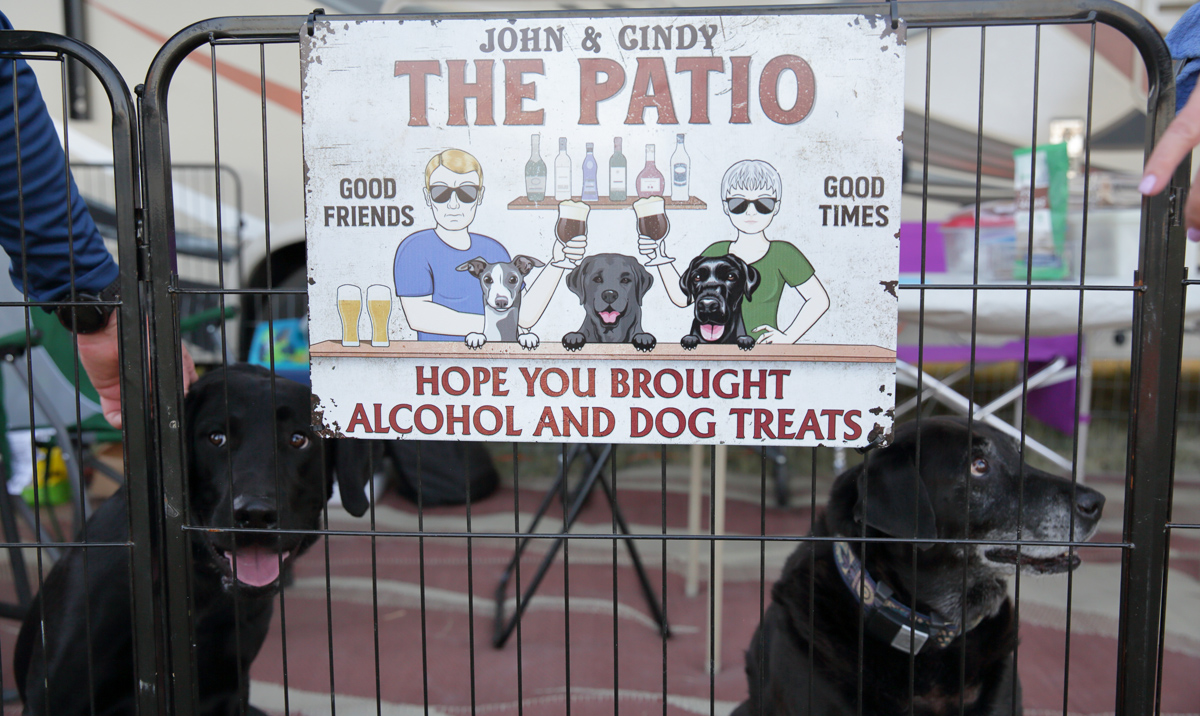 The sign is funny, but true. Three very friendly dogs and two very friendly owners are behind the fence. They have great taste in dogs, telescopes, and beverages, and it's always a good day when we can hang out. We collaborate on meals and beer tastings, and this is really helpful when the weather does not cooperate. The reveal After a little bit of tasting and some food (grilled veggies and pork chops), the shadow of the mesa finally shaded our area, and I set up my new telescope before moving the car out onto the camp driveway for the evening. 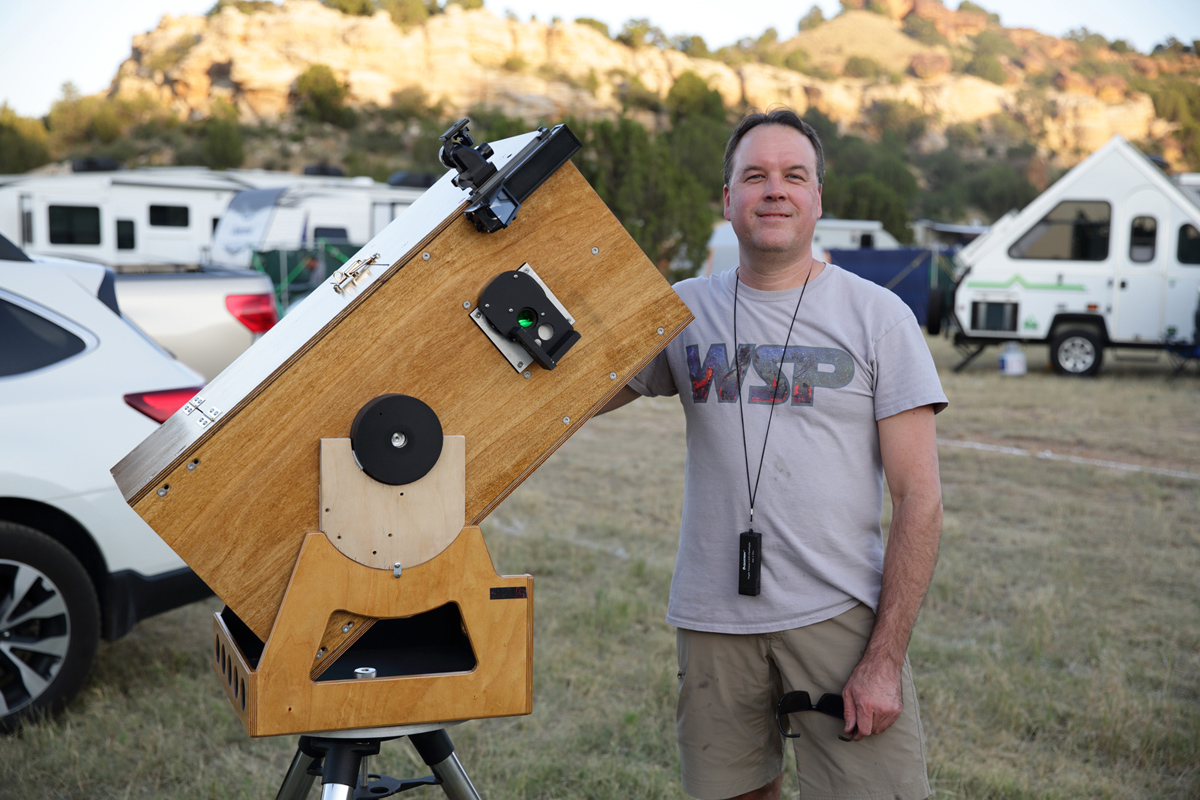 Well here it is, a 12.5" f/2.0 corrected not-quite Newtonian. That's all I'm saying for now, it's proprietary. The rocker box from my 12.5" f/12.5 Cassegrain was borrowed and temporarily modified to accept the OTA. 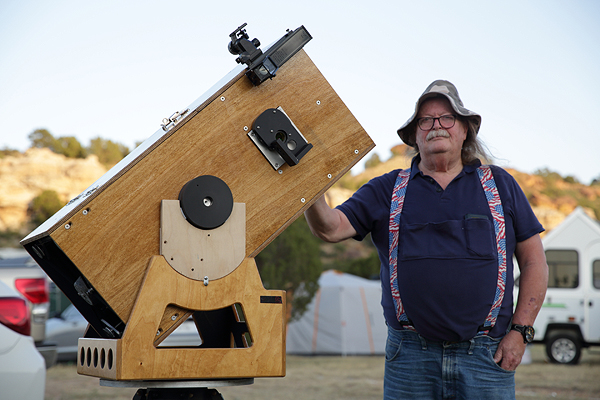 For some time, I had wondered how a moderate to large-aperture (say 10" or larger) dedicated nightvision telescope would perform. One day I got the idea to ask optical designer Mike Jones what might be possible for a telescope dedicated to H-alpha light and the spectral region around that. I am not afraid to make fast optics, so I asked for a system around f/2.0 if possible. Well, Mike soon came back with a nice design for a telescope using a concave primary mirror, a flat mirror, and a corrector. It was possible, and I could build it if I could get the corrector made. Everything would be properly coated for the range of nightvision response to light. In the image at right, Mike is seen with the telescope. The nightvision unit would be the prime-focus variety, using the Mod3c housing with a little bit of creativity. I have been a huge proponent of afocal nightvision for a long time now, and I still do that with my other telescopes because it allows me to change powers and use high power. However, to go ultra-fast another solution is needed, so I'm entering the prime-focus world, too. Vic Maris, president of Stellarvue, provided a quote for the lenses, agreed to make five sets of corrector lenses for me, had the housings machined, and assembled the correctors. Vic is a client - I met him some time ago when he ordered a 16" mirror from me. I took delivery of a corrector and began my build in August, finishing up some minor details just before I left for Okie-Tex. I decided to not use a traditional focuser, because a low-profile, large-diameter focuser was not readily available for a price that I could justify. Instead, I conceived and implemented my own vision/design of a moving-primary mirror focusing mechanism using four leadscrews connected by pulleys and belts used in 3D printers, and thus readily available. The actual focus knob is in the inside corner of the tube at lower left (when viewed from the front), so one hand can rotate the filter wheel, and the other hand can focus to adjust for the focus shift caused by filters of different thickness. I was surprised at how well it worked with excellent smoothness and no significant image shift. My machining skills improved as I built, as did my familiarity with my own machine tools. I have done machining in the past, but certain operations that I had to do were new, and I had to figure out how to secure various parts for machining. I used aluminum extrusion with t-slots to construct square frames, to which the wooden sides of the telescope are attached with bolts and t-nuts. It was not the lightest possible construction, but it was easy, and I could do it quickly. I machined a plate to which the corrector and filter wheel were attached with machine screws, and another plate assembly attached to the other side of the filter wheel and accepted a Mod3c nightvision monocular. This is a prime-focus monocular with no 1x objective lens. I had two units from Tactical Nightvision Company (TNVC), one a normal Gen3 tube, and the second a supergain Gen3 tube. Supergain tubes have roughly twice the amount of maximum gain, around ~110,000 versus ~55,000 typically. My goal was to compare the two tubes and document it with images. This was going to be interesting, educational, and fun! 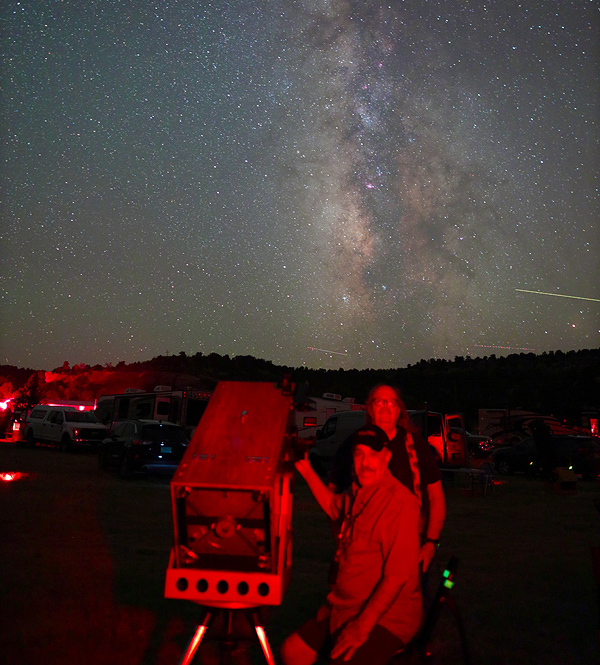 The
filter wheel is a ZWO five-position 1.25" manual
filter wheel, and is placed as close to the nightvision
housing as was physically possible with the filters in their original
threaded housings, resulting in almost no vignetting. A normal
Mod3c housing presents some challenges due to the location of the gain
knob and battery compartment, so TNVC implemented a clever
modification for me to allow the nightvision unit in very close to
the filters. The metal housing allowed me to bolt things to both
sides of it, simplifying my build quite a bit. The
filter wheel is a ZWO five-position 1.25" manual
filter wheel, and is placed as close to the nightvision
housing as was physically possible with the filters in their original
threaded housings, resulting in almost no vignetting. A normal
Mod3c housing presents some challenges due to the location of the gain
knob and battery compartment, so TNVC implemented a clever
modification for me to allow the nightvision unit in very close to
the filters. The metal housing allowed me to bolt things to both
sides of it, simplifying my build quite a bit.The filters in the wheel are shown in the first photo in this article, but here's the list: 1) a Baader 490nm longpass (the equivalent of no filter for this instrument), 2) a Celestron UHC/LPR (surprisingly works very well with nightvision), 3) an Astronomic 12 nm H-alpha, 4) a Baader 6 nm f/2 high-speed H-alpha, and 5) a Baader 3.5 nm f/2 high-speed H-alpha. The focusing mechanism is mostly to account for slightly different filter thicknesses, most notably for the Astronomic 12nm H-alpha out of this group. The other filters are fairly similar thicknesses. The focusing mechanism also allows extra out-travel so that objects relatively close to the telescope can be focused. I assumed that at some point, this telescope would be used for terrestrial targets of finite distance to satisfy curiosity or for surveillance, and I was correct. Thanks to my implementation of this capability, we would later view Okie and Tex - the plastic flamingos on the mesa to the east of the camp - in exquisite detail and darkness illuminated only by light from the sky. We were impressed with the sharpness of the scrub brush, vegetation, and blades of grass that we could see as well. The field of view is just over 1.6 glorious, razor sharp, light-amplified degrees, so a Telrad is quite sufficient for finding most objects in the sky, and the rest can be found by sweeping around in the nearby area. If one is truly a glutton for nightvision and wishes to exploit nightvision to a logical degree that might seem excessive to some, but perfectly reasonable to me, I put a mount on the top of the tube. That mount can accept a 1x nightvision monocular so that a filtered view can be seen at low power, and H-alpha objects or other things that show up readily in the 1x unit can be easily acquired and then examined in the main telescope. If you're going to do it, don't do it half-assed, as I like to say! To hold the 5.0" minor-axis secondary mirror (yes, it's a large obstruction, but it is f/2 and nightvision so it doesn't matter), I used a conventional shell from Astrosystems married with an aluminum disk rather than a resin disk. Together with another aluminum disk that held the adjustment screws, this formed a very rigid adjustment mechanism. I implemented my version of an offset spider design, mounting the secondary assembly off-center to implement the proper offset, and not using the traditional center threaded rod to save space (and tube length) and weight. I used a much shorter pivot bolt. The spider and secondary can be seen in the photo below at right. The disk is simply bolted to one of the two hub pieces for the spider, which are joined by two bolts. The vanes wrap around the bolts through an angle of 90 degrees, so that there are four diffraction spikes. I have to say, the spider is rock-solid, and it was very simple to build. Offset spiders do not allow secondary rotation due to an offset (and thus off-balance) secondary mirror, or due to wind-induced rotational oscillation, which turns stars into lines in breezy conditions. The image below at right shows the front of the telescope, with a carefully-sized baffle in front of the offset spider and my simplified secondary mount. The focus knob is seen at lower left, and can be operated easily while switching filters. The shaft inside the tube leading to the mirror cell can just be seen near the end of the bottom left spider vane. The telescope was not yet fully blackened and baffled, but at Okie-Tex stray light is not an issue. 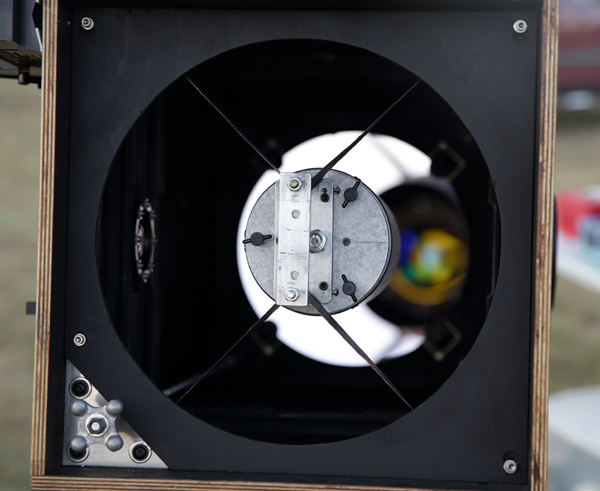 The great thing about this star party was that Vic and Mike were able
to attend, so they got to see the telescope work in real-time under
great skies on this superb Friday night. The telescope lacked
some light baffling, but
it functioned beautifully after I quickly figured out
collimation. Before
I left home for the star party, I had fought the weather, and at one
point I simply focused on stars near
the horizon during testing (before I had the rocker box ready). I
literally set the telescope on a cart and propped up the front end a
bit. I
got the collimation as close as I
could. I knew that the telescope focused and worked, but I had
not viewed any
deep-sky objects with it until darkness fell on that beautiful, warm,
dark night
near
Kenton, OK.
The great thing about this star party was that Vic and Mike were able
to attend, so they got to see the telescope work in real-time under
great skies on this superb Friday night. The telescope lacked
some light baffling, but
it functioned beautifully after I quickly figured out
collimation. Before
I left home for the star party, I had fought the weather, and at one
point I simply focused on stars near
the horizon during testing (before I had the rocker box ready). I
literally set the telescope on a cart and propped up the front end a
bit. I
got the collimation as close as I
could. I knew that the telescope focused and worked, but I had
not viewed any
deep-sky objects with it until darkness fell on that beautiful, warm,
dark night
near
Kenton, OK.In the image above, Vic and Mike pose with the telescope under the Okie-Tex sky. I had to paint them with red light so they were visible, so I couldn't join them in the photo. The night was beautiful, with warm temperatures, light winds, a transparent sky, and good people around us. While a few people did wander by and have a look, for the most part the only people that viewed through the telescope were me, Mike, Vic, and John. In the end, I wish a few more had seen it, though we did stay busy the entire night. We took a few breaks to sit down and rest our legs, but mostly we were up and observing. Collimation of the secondary and rough primary collimation are accomplished with a cheshire eyepiece, and then I do a fine adjustment of the primary tilt to make out-or-focus star images round. That's it. I was surprised at how easy this was to do to achieve pin-point star images, limited only by the nightvision unit and its ocular. Rough alignment of the primary for the very first time was done by removing the belt from the leadscrews, and using those to adjust tilt of the entire mirror cell. With the belt replaced, the fine collimation adjustments that I built in could be used as I viewed a defocused moderate-brightness star in the nightvision ocular. Simply move the star toward the "tail" of the coma until there is no more tail, and you're done. (See my article "Why Aren't My Stars Round?" for this procedure.) We knew that the moon would rise before 3am, so we crammed in all of the objects we could think of. I was hand-holding the 1x monocular to track down more objects in the winter part of the Milky Way at one point, one eye enjoying the H-alpha filtered view and the other the naked eye view. Despite the brightness difference, my eyes merged the views quite well after I got used to it. It was a weird but wonderful fusion of technology and the natural view, and I almost felt like a cyborg (or Borg) with one electronic eye and one biological eye as I scanned the sky, seeing H-alpha objects almost overlayed on the real sky. The corrected design of the properly aligned telescope gives perfectly sharp star images out to edge of the field. Visual and photographic resolution is limited only by the optical performance of the ocular on the nightvision unit. Though sharp at the center of the field, the ocular does show slight aberration at its edge. Other optical aberrations are below the diffraction limit and smaller than the resolution of the nightvision unit itself, which ends up is the limiting factor in optical performance. Taking advantage of this utter sharpness to scan around, some of my favorite views were of the dense, star-rich portions of the Milky Way with dark nebulae scattered seemingly everywhere. Globulars in the Sagittarius region were so crisp and obvious that it made me smile. I could see knocking out the entire Barnard catalog for a region of the sky quite quickly with this instrument. Mike took some photos with his phone, thankfully. I figured that I would be able to do this on later nights, so I concentrated on observing, not image acquisition. Below are two of his images, the first of the Lagoon (M8), and the second of a dense starfield that I found somewhere in the Milky Way. 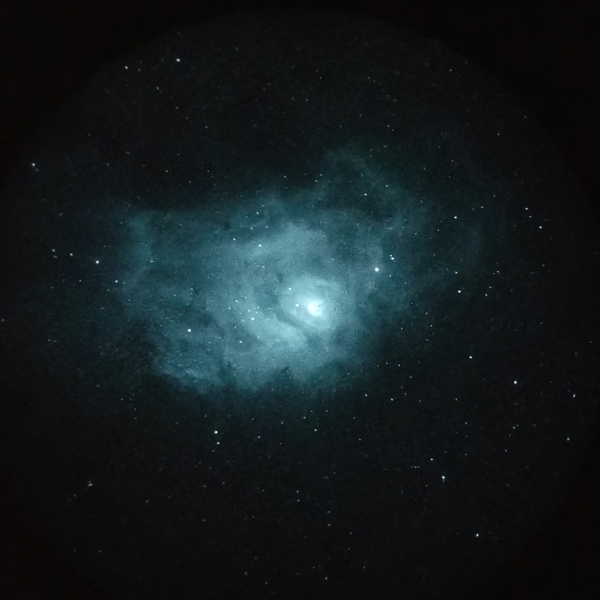 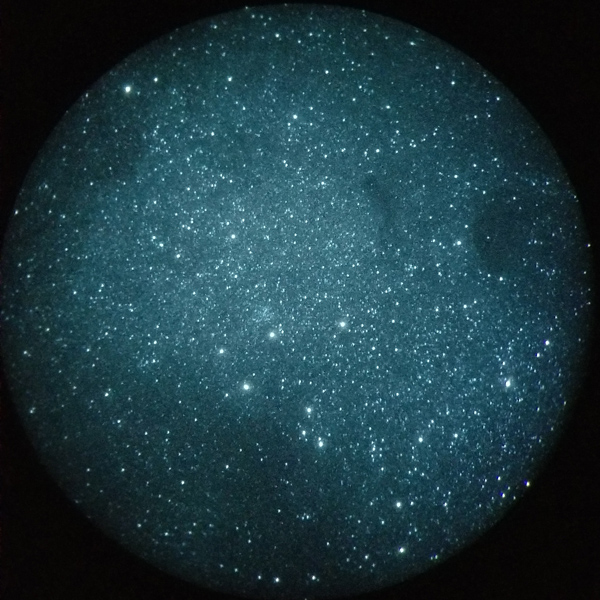 Of course the cell phone camera has its own limitations and aberrations, and it does not really do justice to the real view, but it's all we managed to get that night, so thank you to Mike for taking some images. (If you see anyone online that has nothing better to do than attempt to find various aberrations in these cell phone images taken through an eyepiece, they have absolutely no clue what they are looking at or talking about, and you should ignore their bullshit.) The weather looked uncertain for later nights, so we wanted to make sure we got to enjoy the views while all three of us could enjoy them together. Vic stepped away at times to man his large refractor, but when he returned we mostly caught him up on what we had been viewing. We ended the night around 2am when we were all tired, but very pleased with the night and the telescope. It was fantastic for us to see it all come together and work as it was designed. After I left the field and went back to the house, I ended up staying up even later working on a quote that needed to be submitted, and then I slept in as late as I could. 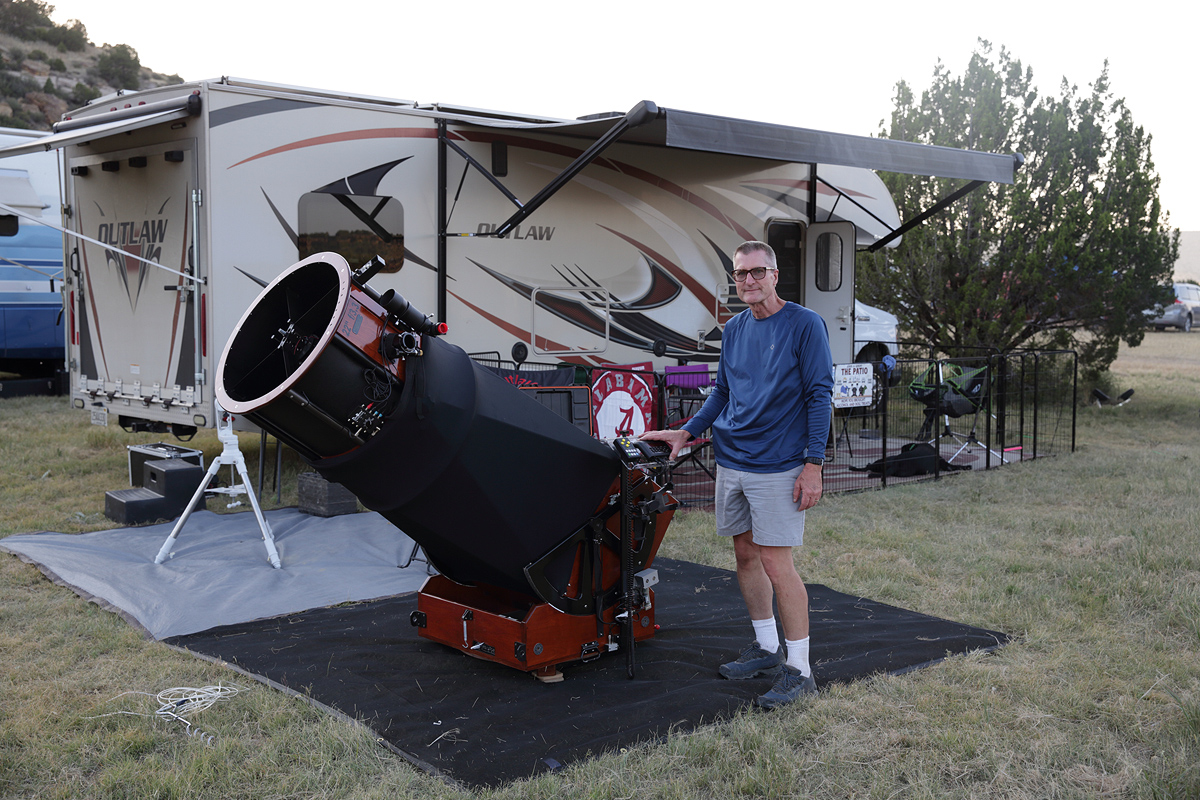 I also observed a bit with John's excellent 22" f/3.3 JPAstrocraft that uses a quartz primary that I made. It performs very well in the Okie-Tex heating/cooling cycle that is experienced on most days. Saturday was no exception. It started off sunny and warm, but then storm clouds began to build to the east and southeast. I knew we were on the edge of a large weather system, and we all hoped it would stay east of our location. 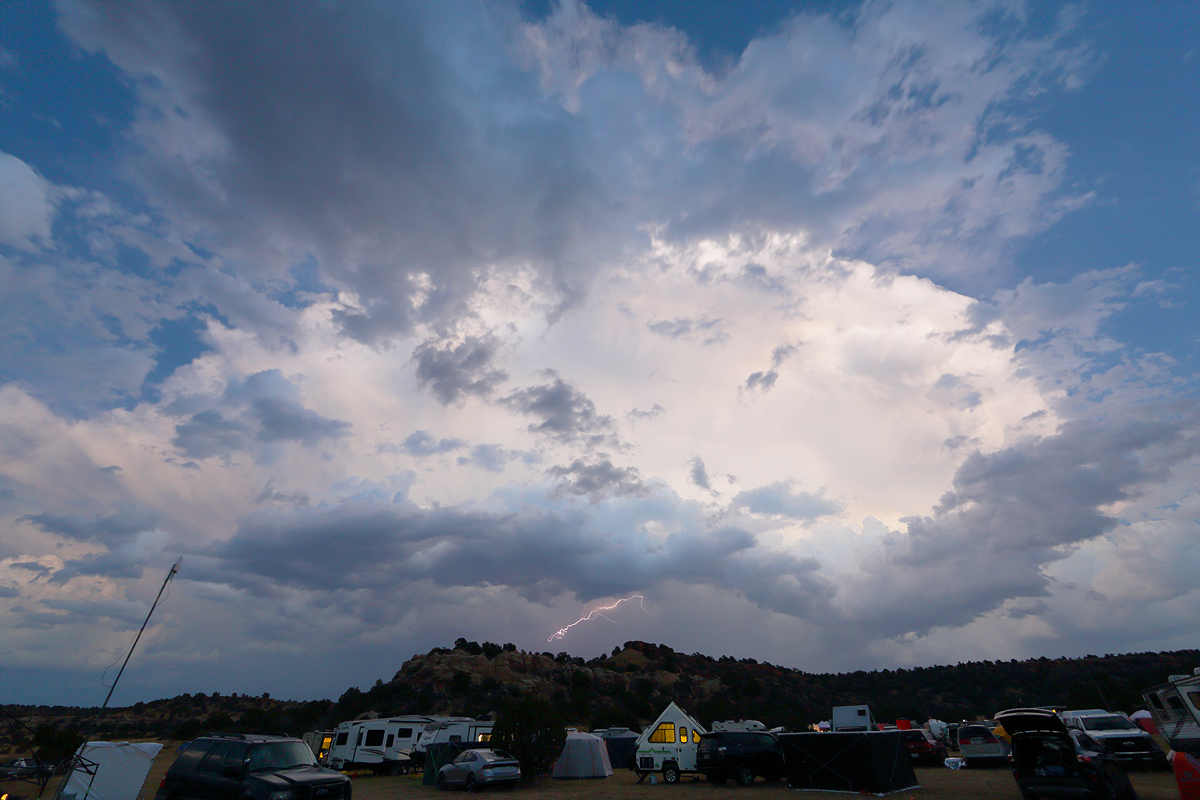 By evening, the storm was a spectacular feature in the eastern sky, and we watched powerful updrafts build the cloud in real time. Some of the time lapses that people captured were quite impressive, but I wanted some lightning shots, and this is the best one. As the sun set in the west, the lighting was beautiful, and cameras and phones appeared everywhere as people captured the scene. Below is my favorite shot - I preferred a narrower field to show the cloud detail. We heard later that very large hail fell on Boise City, OK to the southeast. 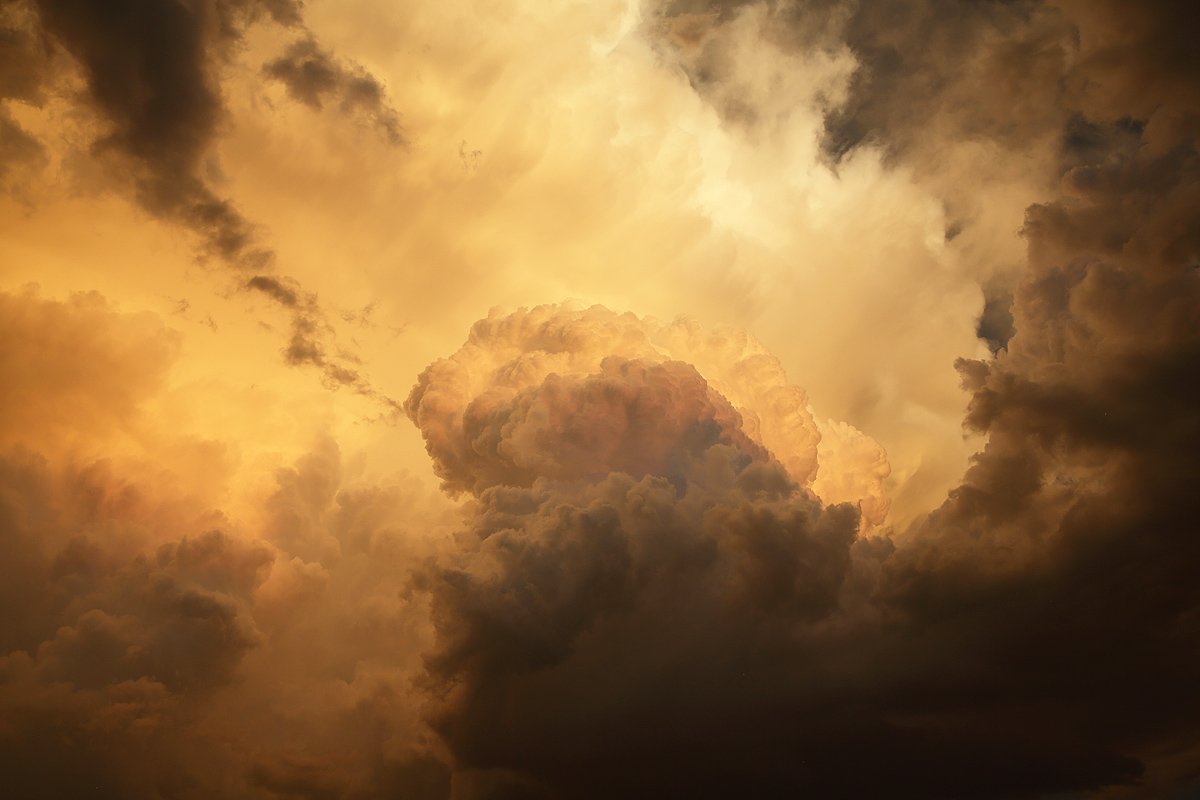 As the clouds persisted in the evening, it did not rain, but it was partly cloudy and breezy. We grilled chicken and veggies and did some beer tasting. With nothing else to do, we ended up watching parts of football games on phones and laptops, including Alabama vs. Texas, and Oklahoma State vs. some team. Later on, the only observing due to the breeze was through Vic Maris' large refractor, and even in that you could see the very turbulent seeing conditions. At some point, I called it a night. On Sunday morning it was sunny, but there was a refreshingly cool breeze after the heat of the previous two days. I went for a run in the morning, worked on my talk, and visited with people. Some storms rolled into the star party region around 5pm, but thankfully the heavier rain went to the south. I believe we ended up with about 1/2" of rain. There was no observing, we hung out until midnight or so, conversing and sipping some interesting beers. Thunder rumbled in the northwest as I walked to my car. Light rain started overnight into Monday. The scene was strange as I awoke and sipped coffee outside standing under a porch roof in the middle of a near-desert. Rain is a good thing, though, and it continued until 3pm or so. I worked on my talks, then headed over for lunch and to visit. We had turkey and potatoes for dinner, and LeRoss, whose house I was staying at, joined us for a small tasting and some dinner. I ended up heading back to the house to watch some football. LeRoss filled me in on some of the finer points of rodeo events while sampling some bourbon. Tuesday morning was cool and cloudy, and I went for another run. It was the perfect weather for exercise, at least for me, and I enjoyed the clean air. Then I finished tweaking my talks and headed over for lunch and then my talks starting at 2:30pm. I had a good crowd, and my talk about thermal effects with video was very popular. I had done it previously, but the video was difficult to see due to lots of light in the old tent. However, now Okie-Tex has its talks in a beautiful new building that has the best meeting room that I know of at any star party. It's air-conditioned and dark when the projector is in use, and has lots of seating. My second talk was about how to read test reports, and I tried to educate people on the various features and quantities that they might see in them. This was a new talk, and I think it was well-received. On Tuesday evening, we ended up in John and Cindy's RV just visiting and doing some beer tasting. Our normal afternoon gathering was smaller, and we saved some beverages for a long cloudy evening. In the picture below, from left to right, Jon Talbot, John, Rex, Will, Bram and Cindy all squeeze into the RV and into the photo frame, along with a blurry Sprite, their Italian greyhound. Yes, Will always has to do something interesting for the camera, he's like that. He's also a nightvision user. Check out his videos on Youtube, he is the Deep Sky Dude. 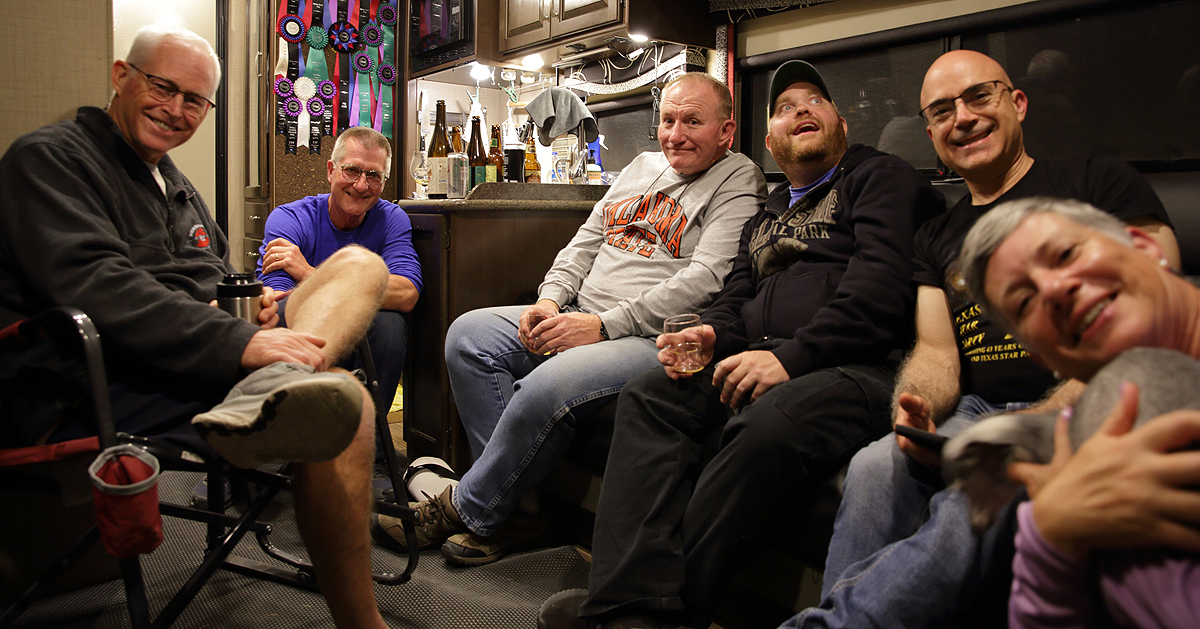 Wednesday was partly sunny in the morning and afternoon, and temperatures were very nice. I headed over for lunch and to find Allan Wade, whom I had not seen in person for quite some time, so there was a lot of catching up to do. He had begun some serious homebrewing, and had managed to bring several excellent beers to share. However, there were other events to attend on this day before the usual beer tasting. It was sushi day, and luckily the weather was cooperating. However, first there was a bit anniversary to celebrate. This was the 40th anniversary of the Okie-Tex Star party, and there was a cake and punch! 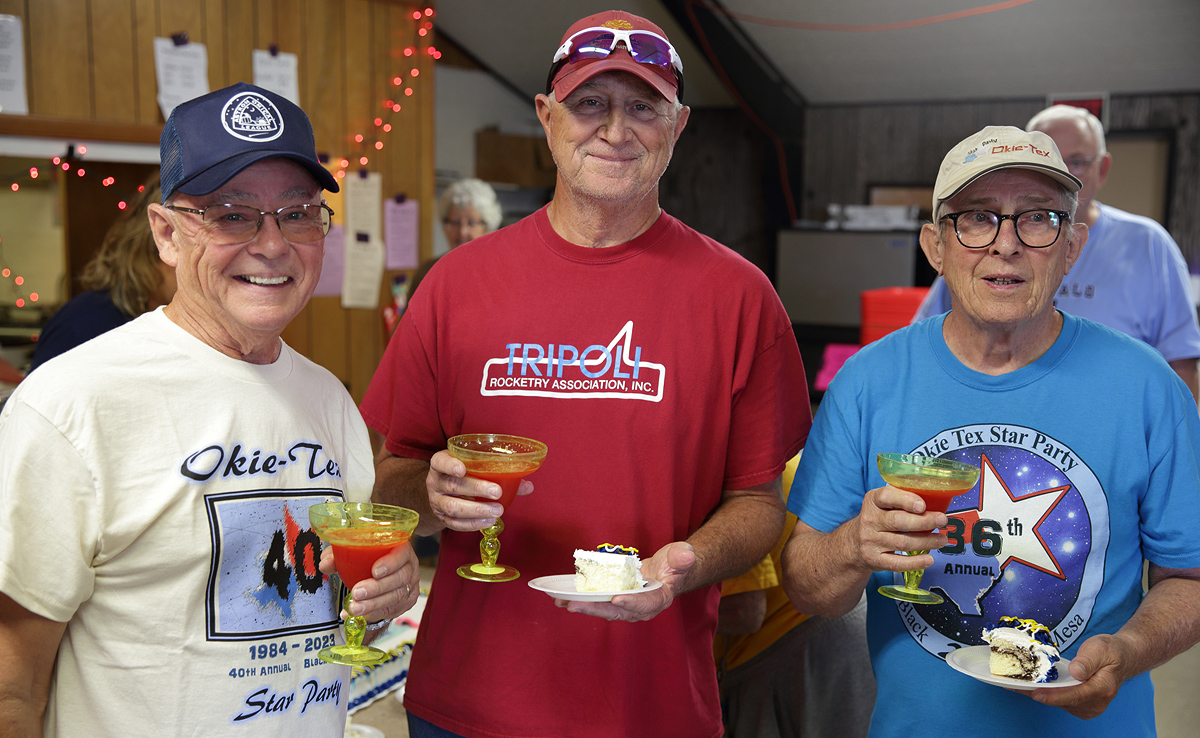 In the photo above, the staff enjoys a bit of dessert in the kitchen/dining hall. I had a piece of cake, and that was plenty (after our small lunch) to hold me over until..... the Great Sushi Extravaganza that Tom, Cathy, and Vance put on! There is sake tasting for those that enjoy it. 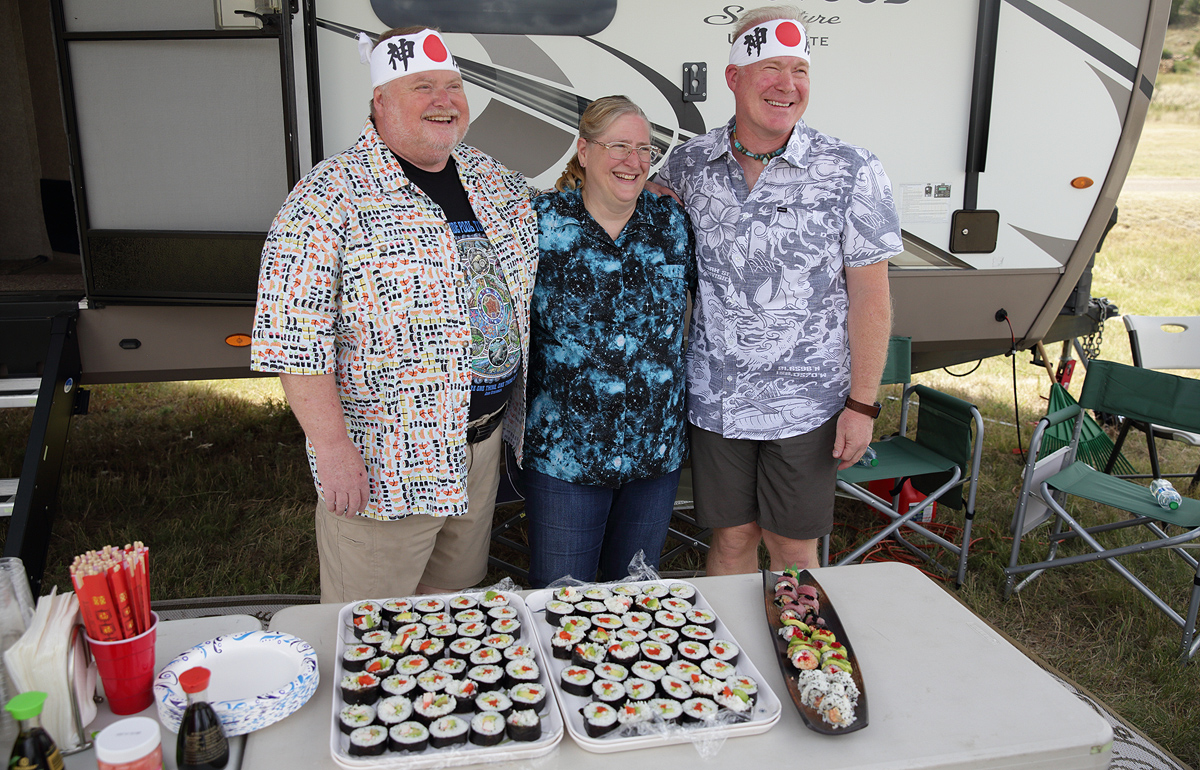 This is always a great way to spend an afternoon with friends, and the sushi is excellent. An annual fishing trip produces a lot of Alaskan salmon, and it is then served up in the form of rolls. Every year, these people fail to disappoint. (That's a quirky way of saying they do a fantastic job.) The gathering is shown below. It gets a lot of people together for an afternoon of socializing and continuing to eat as the sushi just keeps on materializing out of a couple of RVs. 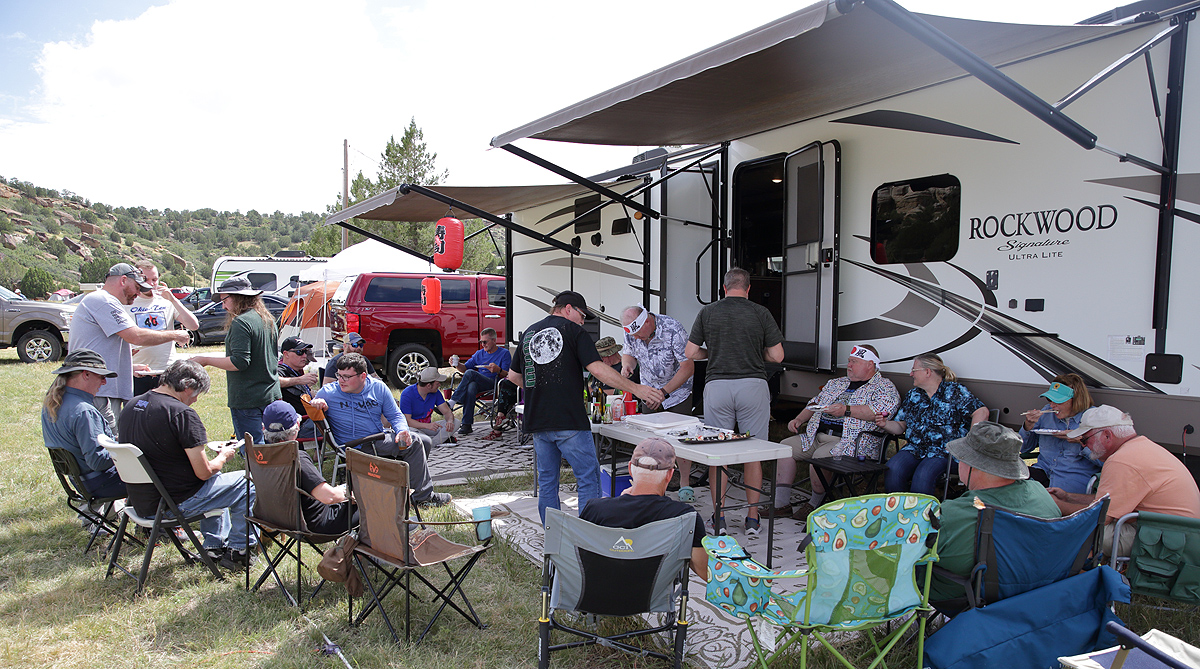 After this, having not sampled sake, but with our stomachs pleasantly full, it was time to have a fantastic beer tasting and sample some of Allan's brews. I had saved some memorable beverages for Allan's arrival, and we enjoyed quite a few of them. The empties, photographed the next morning as I packed up to leave, are shown below. You have to mentally add in two unlabeled bombers (larger bottles) that Allan brought to the image below, and then you'll have the complete picture. Allan's doppelbock and Russian imperial stout were both excellent, particularly the stout. With all of those present, it was just about the right amount for the time we had. 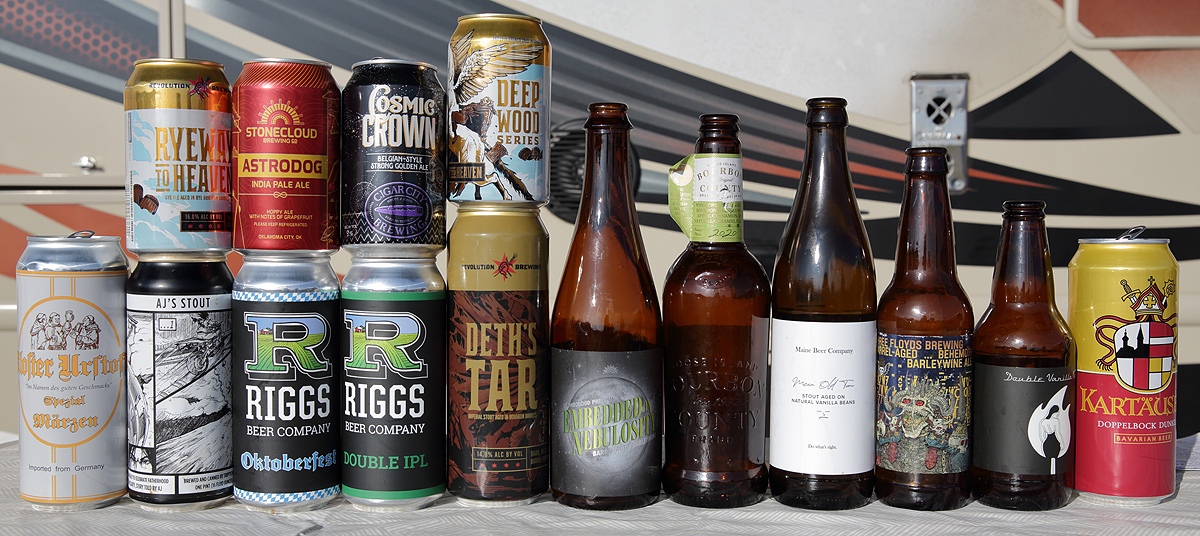 LeRoss stopped by later on, and brought his cattle dog Squirt. He made some excellent margaritas with prickly pear cactus juice, and I sipped one of those as we made our way up for the Wednesday evening door prize drawing. 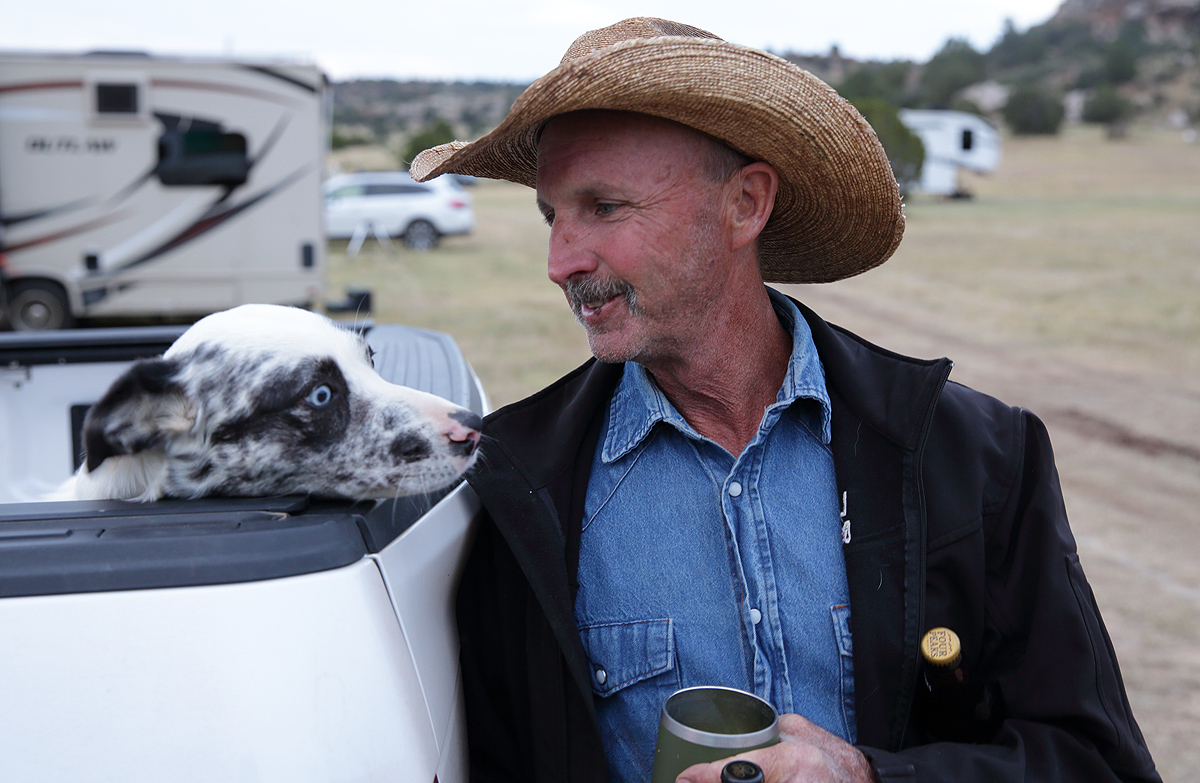 With so many people having left, the odds were pretty good of winning something, and a number of friends did. We wandered back to the cloudy observing field and enjoyed ourselves late into the evening, sitting outside in the dark chatting. Given the weather forecast for the next night, other obligations that I had, and the fact that I hadn't observed the sky since Saturday night, I decided to head out the next morning. I was giving up tasting some more of Allan's homebrew, and that was tough, but I had to go. On Thursday morning I headed east, staying on the northeast side of Kansas City for the night, and then returning in time to unpack the car and join friends for dinner at an Oktoberfest on Friday. I was needed to take photos if I was back in time, and I made it. It was a fantastically crowded, but very fun evening. Then I slept very well. That was the 2023 Okie-Tex Star Party, I hope to be completely exhausted by clear skies and superb visual and nightvision views at next year's event. The NVT The NightVision Telescope is something you will hopefully hear more about in the future. The design is suitable for multiple sizes from the 10" to 24" f/2.0 (with a small modification). I plan to build the 24" f/2.0 for myself in the future! If you are part of an observatory, club, or other organization that does public observing, please contact me if you are interested in building a telescope like this one. Given the speed and asphericity of the optics, they are not cheap, but the potential for public viewing enjoyment and outreach is just about unlimited in my opinion. I have a 16" f/2 optical set that I plan to make that is unsold as of the writing of this article. However, if demand requires it, we can make more correctors and I can make more primary and secondary mirrors. More on this telescope concept in the future........ but until then, clear skies, good beer, good seeing, good friends, and fun observing to all. -Mike Lockwood, -Lockwood Custom Optics, Inc. |